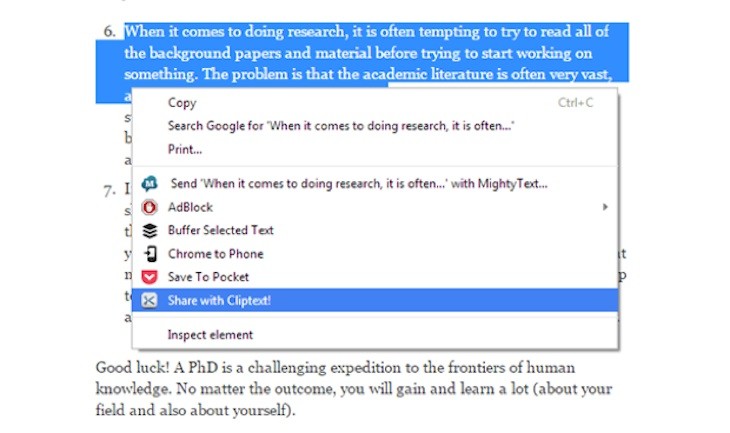The Clipboard interface's readText() method returns a Promise which resolves with a copy of the textual contents of the system clipboard.. The 'clipboard-read' permission of the Permissions API must be granted before you can read data from the clipboard.
Hebrew Cliptext of the Payer Book (Siddur) is an essential add-on to Microsoft Word. The beauty of this program is in its simplicity and its seamless integration into English versions of Microsoft Word. You need to do nothing more than install, and restart your Microsoft Word. Cliptext window The cliptext window is collection of text clips for quick and easy access. You can easily customize them, and you can also create your own cliptext file. ClipText is a tiny app that can be kept running while working between applications with multiple Copy and Paste operations. Download ClipText version 1.40 Requires Windows (anything from Windows 95 onwards) (Can also be run on Mac OS or Linux using a Windows emulator). Cliptext is a mobile application that aims to improve communication, by clipping photos with text caption, 'like a meme' with the option for users to share with others without having to know them. Creating a communication tool that becomes the first thing users log on to when they get to a new city or attend a big event like a concert. Through the years. Access to the Clipboard object has become easier and easier. You might find it strange to have an entire article dedicated to the Clipboard object but the sad fact of the matter is it's obvious properties and methods got lost in translation.
Syntax
Parameters
Return value
A Promise that resolves with a DOMString containing the textual contents of the clipboard. Returns an empty string if the clipboard is empty, does not contain text, or does not include a textual representation among the DataTransfer objects representing the clipboard's contents.
To read non-text contents from the clipboard, use the read() method instead. You can write text to the clipboard using writeText().
Example
This example retrieves the textual contents of the clipboard and inserts the returned text into an element's contents.
Specifications
| Specification | Status | Comment |
|---|---|---|
| Clipboard API and events The definition of 'readText()' in that specification. | Working Draft | Initial definition. |
Browser compatibility
BCD tables only load in the browser
See also
Menu text: Java Compiler
Command: c:javabinjavac.exe
Argument: '$(FilePath)'
Initial directory: $(FileDir)
Capture output: ON
Example 2. Turbo C 2.01
Menu text: Turbo C
Command: c:tctcc.exe
Argument: -Ic:tcinclude -Lc:tclib -n$(FileDir) $(FilePath)
Initial directory: c:tc
Capture output: ON
Example 3. Borland C++ 5.5
Menu text: Borland C
Command: c:bcbinbcc32.exe
Argument: -Ic:bcinclude -Lc:bclib -n$(FileDir) $(FilePath)
Initial directory: c:bcbin
Capture output: ON
Example 4. Visual C++
Menu text: Visual C++
Command: c:msdevvc98bincl.exe
Argument: '$(FilePath)'
Initial directory: $(FileDir)
Capture output: ON
The above settings must be replaced with the actual path of the Java compiler or C/C++ compiler on your system.
After the setting is completed, you can run the command on 'Tools' menu, and the result will be shown in the Output Window at the bottom. You can also run the tool through the shortcut key (Ctrl + 0-9) or thought the icons on the 'User toolbar'.
To run the compiled Java class file, you can set the options like this:
Menu text: Java
Command: c:javabinjava.exe
Argument: $(FileNameNoExt)
Initial directory: $(FileDir)
The 'Command' field should be replaced with the actual path of the Java interpreter.
To run the compiled *.exe file, you can set the options like this:
Menu text: Run
Command: $(FileNameNoExt)
Argument:
Initial directory: $(FileDir)
1. select 'Settings & syntax' page on the Preferences dialog box.
2. Select desired file type or press Add button if you cannot find any. When you add a new file type, enter the file extension on the 'File extension' field.
3. Enter the full path of the STX and ACP file on the 'Syntax file' and 'Auto completion' field.
To add a *.CTL file:
*.CTL file is 'cliptext' file which you can use in the Cliptext Window. To add a *.CTL file, copy it to the Syntax Directory (see 'Tools'->'Set Directories') and restart EditPlus. If the cliptext window is hidden, you can use 'Cliptext Window' command on 'View' menu to show it at the left side of the main window.
1. Start Explorer.
2. Locate one of the above files in the windowssystem directory.
3. When over the file click the right mouse button.
4. Choose 'Properties' from the speed menu.
5. Choose the 'Program' tab.
6. Turn on the 'Close on exit' option.
Example:
Command: WinDiff.exe
Argument: $(WindowList)
epp320.exe -s -sp-s
FAQ in Polish
Click here for support and feedback
Clip Text Excel
 Things to do...
Things to do...●
Clip Text In Photoshop
Buy NowClip Text From Image
●Download and try it now
●
Clip Text To Image
Check out features●See screenshots
Clip Text Css
